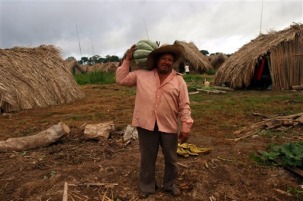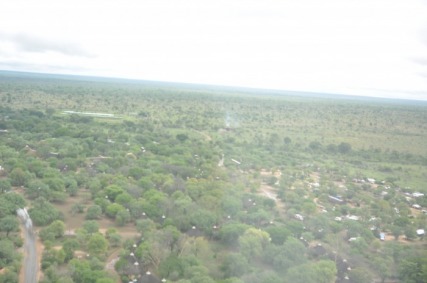Zimbabwe: Land Redistribution
Elizabeth Szokol

. One of the most critical issues Zimbabwe currently faces is that of land redistribution. Since the 1990’s, land has been taken from the white landowners and given to landless blacks in order to provide equality within the country of Zimbabwe. (World Geography). The President of Zimbabwe, President Mugabe, argued for permission to redistribute land to the blacks. Permission was granted to Mugabe, but where are they going to get the land from? (World Geography). The government took the land from white landowners and in 2002 a law was passed that allowed Zimbabwe’s government to take away white owned land. (Britannica Book of the Year, 1998). Already, Zimbabwe’s government had enough power to take white landowners’ land away and give it to the landless blacks, but the worst solution is to give the government more power.
When is a country’s government too powerful? A country’s government becomes too powerful when they can change any laws and overrule everyone. Zimbabwe’s government has reached the stage when they have too much power. In 1980 the Lancaster House Agreement was created. (Human Constitutional). The Lancaster House Agreement granted white land owners ten full years of land distribution protection. (Human Constitutional). When this agreement wore off in 1990, there was an enormous change in the composition of the government resulting in the government being able to take away white owned land. (Human Constitutional). By the year 2000, several thousands of white farms were given to landless blacks. (Global Issues in Context). In the same year of 2000, President Mugabe amended the constitution, therefore adapting his laws into action. (World Geography). He changed the constitution so he would not have to provide compensation to landowners from which the government took land. This action is an extreme violation of power and should be viewed as unjust. The next significant event took place in 2002. (Britannica Online). This event was the passing of the law that granted Mugabe the power to randomly take away white owned land. (Encyclopedia Britannica). Mugabe then used his power to gain more power, which resulted in an overall abuse of power. It appears the fair solution to Zimbabwe’s land redistribution problem is not to give the government more power.
When is a country’s government too powerful? A country’s government becomes too powerful when they can change any laws and overrule everyone. Zimbabwe’s government has reached the stage when they have too much power. In 1980 the Lancaster House Agreement was created. (Human Constitutional). The Lancaster House Agreement granted white land owners ten full years of land distribution protection. (Human Constitutional). When this agreement wore off in 1990, there was an enormous change in the composition of the government resulting in the government being able to take away white owned land. (Human Constitutional). By the year 2000, several thousands of white farms were given to landless blacks. (Global Issues in Context). In the same year of 2000, President Mugabe amended the constitution, therefore adapting his laws into action. (World Geography). He changed the constitution so he would not have to provide compensation to landowners from which the government took land. This action is an extreme violation of power and should be viewed as unjust. The next significant event took place in 2002. (Britannica Online). This event was the passing of the law that granted Mugabe the power to randomly take away white owned land. (Encyclopedia Britannica). Mugabe then used his power to gain more power, which resulted in an overall abuse of power. It appears the fair solution to Zimbabwe’s land redistribution problem is not to give the government more power.

Zimbabwe’s government has an excessive amount of power, therefore minimizing if not eliminating Zimbabwe’s citizens voice in the government’s decisions. Through land redistribution, land was taken away from white landowners and given to blacks. The white people were angered by the government’s strong actions as they took the white people’s land away. One percent of the population in Zimbabwe is white, but fifty percent of farmable land was owned by this one percent. (World Geography). Imagine if the land you worked hard for and had many memories with was taken away from you. This was the reality that many white people had to face in 1999. In 1999, President Mugabe began to force landowners to give up their land because he could no longer simply take away the land. The landowners had no choice, vote, or say in the matter. (World Geography). President Mugabe wanted more power and more land so in 2000 he adopted “fast tracks”. (Human Constitutional). Fast tracks benefited 160,000 landless people but it did nothing to benefit the landowners. This policy continues to exist today but it is not effective. If the landowners had a say in the policy, they may have not agreed to it or could have come up with a much more meaningful and equitable plan. Zimbabwe’s government must be willing to accept advice and give up some of their power.
Currently, there are several issues with which Zimbabwe has battled with. One of the main issues is land redistribution which has effected hundreds of thousands of people, both black or white and rich or poor. Zimbabwe’s government is in a unique position as it has the power to make laws and policies without consulting citizens. If the citizens could give advice to the over powerful government regarding land redistribution, a more effective plan could be put in place. Part of the answer to solving Zimbabwe’s land redistribution issue is by allowing the Zimbabwe citizens to have a voice and give some power to them. The worst scenario is to allow Zimbabwe’s government to rapidly gain power and initiate laws without the involvement of its constituents.
Currently, there are several issues with which Zimbabwe has battled with. One of the main issues is land redistribution which has effected hundreds of thousands of people, both black or white and rich or poor. Zimbabwe’s government is in a unique position as it has the power to make laws and policies without consulting citizens. If the citizens could give advice to the over powerful government regarding land redistribution, a more effective plan could be put in place. Part of the answer to solving Zimbabwe’s land redistribution issue is by allowing the Zimbabwe citizens to have a voice and give some power to them. The worst scenario is to allow Zimbabwe’s government to rapidly gain power and initiate laws without the involvement of its constituents.
"Zimbabwe Government and Farmers Locked in Land Reform." Human Constitutional. 2008. 12 May 2009 http://www.hrcr.org/hottopics/Zimbabwe.html.
This article gave me a great overview of land redistribution is Zimbabwe. It also provided me with many dates of events that happened. This article was a great source to use.
“Zimbabwe Reaffirms Land Redistribution Policy” Global Issues in Context. (2007). 12 May 2009.
This website provided me with many facts and numbers. This information was very helpful in my paper.
“Zimbabwe: Contemporary Issues” World Geography. 2009. ABC-Clio. 13 May 2009. http:www.worldgeography.abc-clio.com/countries/Display.aspx?regionid=1&countryid=218&pagetypeid=6
This article provided me with many dates of events that took place. In addition, the website gave me information on many of the policies that were created.
“Zimbabwe” Britannica Book of the Year, 1998. 2009. Encyclopedia Britannica online. 13 May 2009. http://search.eb.com/eb/article-9114502.
This article gave me little information but it was very helpful. It gave me an idea of what was happening to the country of Zimbabwe during land redistribution.
“Zimbabwe”. Encyclopedia Britannica. 2009. Encyclopedia Online. 13 May 2009. http://search.eb.com/eb/article-278297
This article provided me with many numbers. It also gave me information on what laws were passed and why they were passed.
This article gave me a great overview of land redistribution is Zimbabwe. It also provided me with many dates of events that happened. This article was a great source to use.
“Zimbabwe Reaffirms Land Redistribution Policy” Global Issues in Context. (2007). 12 May 2009.
This website provided me with many facts and numbers. This information was very helpful in my paper.
“Zimbabwe: Contemporary Issues” World Geography. 2009. ABC-Clio. 13 May 2009. http:www.worldgeography.abc-clio.com/countries/Display.aspx?regionid=1&countryid=218&pagetypeid=6
This article provided me with many dates of events that took place. In addition, the website gave me information on many of the policies that were created.
“Zimbabwe” Britannica Book of the Year, 1998. 2009. Encyclopedia Britannica online. 13 May 2009. http://search.eb.com/eb/article-9114502.
This article gave me little information but it was very helpful. It gave me an idea of what was happening to the country of Zimbabwe during land redistribution.
“Zimbabwe”. Encyclopedia Britannica. 2009. Encyclopedia Online. 13 May 2009. http://search.eb.com/eb/article-278297
This article provided me with many numbers. It also gave me information on what laws were passed and why they were passed.
Last updated by Elizabeth Szokol at 7:33 a.m. Friday May 22, 2009

